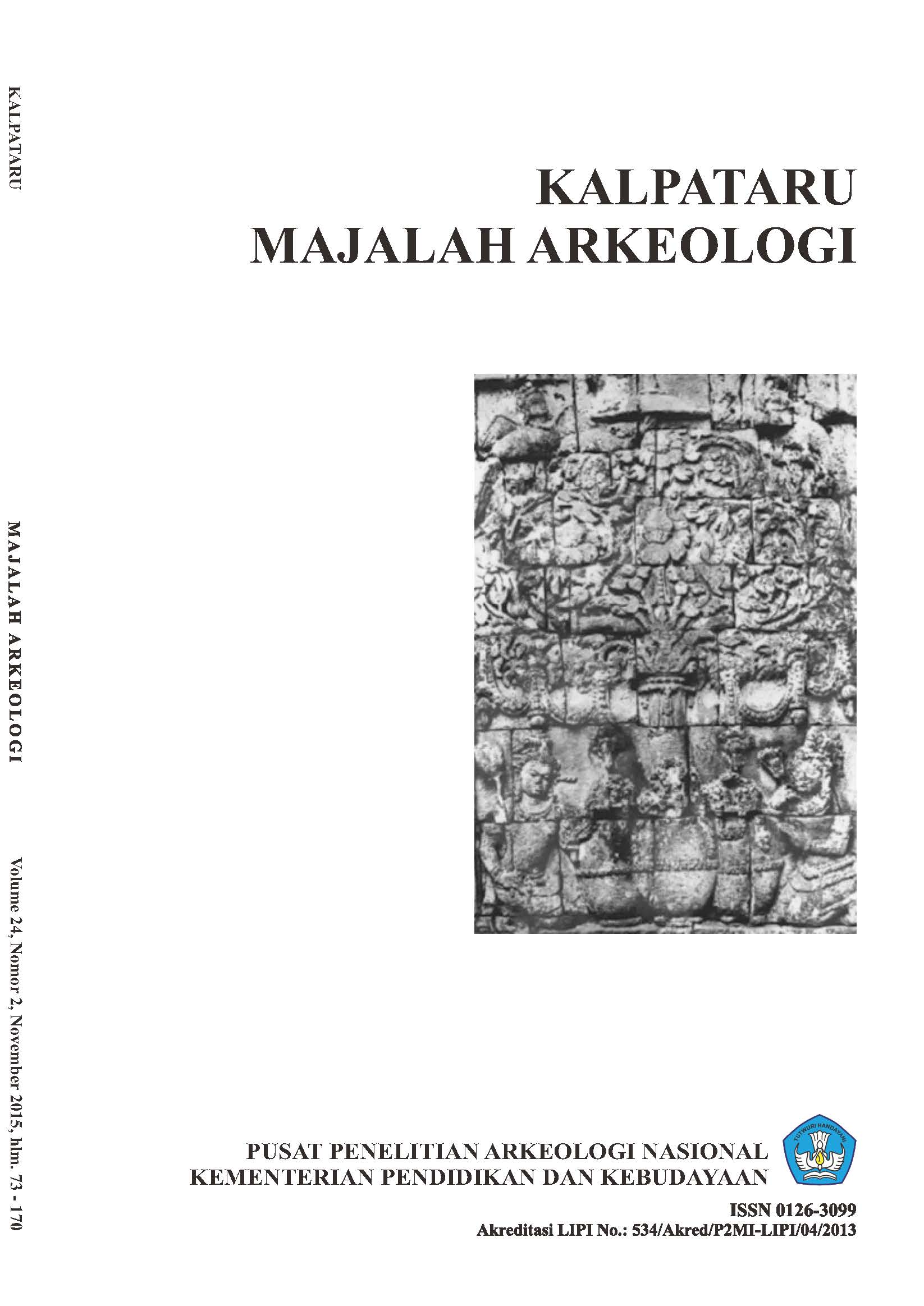KILAS BALIK SEJARAH BUDAYA SEMENANJUNG BLAMBANGAN, BANYUWANGI, JAWA TIMUR
Main Article Content
Abstract
Blambangan peninsula, known as Alas Purwo located in Banyuwangi. Alas Purwo, also means “early forest” in Javanese language, has a lot of archaeological potential, moreover the dense forest which is one of the constituent elements of the karst landscape enables support for human life in prehistoric era. Data from various sources says that in the Alas Purwo found the remains of the other past culture. In addition, isolated location provide opportunities for data that is pristine and not much transformed. The purpose of this research is to collect data of archaeological and ethno-history potency of Alas Purwo in three dimensions, which is: the dimensions of form, space, and time, in order to obtain a conclusionon the cultural history Blambangan Peninsula. The research methods is explorative with three approaches, archaeological approach, ethno-historical approach and geographical approach with the Geographic Information System (GIS). The research proves that Blambangan Peninsula has cultural history value as well. This result can be proved from complete archaeological and ethno-historical remains dating from the Prehistoric, Classical, Islam, and the Colonial era with local, national, and international issues. Spatially, the distribution pattern of the archaeological remains show fundamental variations, such as locational characteristics.
Semenanjung Blambangan atau dikenal dengan Alas Purwo terletak di Kabupaten Banyuwangi. Alas Purwo yang dalam bahasa Jawa diartikan sebagai ‘hutan awal’ memiliki banyak potensi arkeologi. Hutan lebat Alas Purwo merupakan salah satu unsur penyusun bentang lahan karst yang memungkinkan mendukung kehidupan manusia masa Prasejarah. Data dari berbagai sumber menyebutkan, bahwa di Alas Purwo ditemukan tinggalan sisa budaya masa lalu lainnya. Selain itu, lokasiyang terisolasi memungkinkan diperolehnya data yang masih asli dan tidak banyak mengalami transformasi. Tujuan penelitian adalah pendataan potensi arkeologi dan etnohistori Alas Purwo dalam tiga dimensi, yaitu dimensi bentuk, ruang, dan waktu. Dengan demikian,dapat diperoleh kesimpulan sejarah budaya Semenanjung Blambangan. Metode penelitian bersifat eksploratif dengan tiga pendekatan, yaitu pendekatan arkeologi, pendekatan etnohistori, dan pendekatan geografi dengan perangkat Geographic Information System (GIS). Hasil penelitian menunjukkan bahwa Semenanjung Blambangan memiliki nilai sejarah budaya cukup panjang dan penting. Hal ini terbukti dari lengkapnya tinggalan arkeologi serta etnohistori yang berasal dari masa Prasejarah, Klasik (Hindu), Islam, dan Kolonial yang menyimpan isu lokal, nasional, dan internasional. Secara spasial, pola distribusi tinggalan arkeologi tersebut memperlihatkan variasi mendasar, seperti lokasi yang khas.
Article Details
This work is licensed under CC BY-NC-SA 4.0
Authors whose articles are getting published must agree with the following rules:
- Publication rights for all contents published in Kalpataru Journal (printed and online versions) belong to The Board of Directors with acknowledgment of the authors (morale right still belongs to the author)
- Legal formal regulation for digital access to electronic journal follows the rule of Creative Commons license Commons Attribution-NonCommercial-ShareAlike (CC BY-NC-SA), which means Kalpataru Journal is a non-commercial publication, holds the right to keep, format, and manage the articles into the database, maintain, and publish articles
- Published articles both in printed and online versions are accessible for all purposes of education, research, and library archives. The board of directors is not responsible for any violations of the copyrights outside those purposes.
References
Badan Informasi Geospasial. 2012. Mempertahankan Benteng Terakhir di Kawasan Karst Selatan Jawa Timur, Ekspedisi Geografi Indonesia. Jakarta: Badan Iinformasi Geospasial.
Basset, D.K. 1964. “British Trade and Policy in Indonesia 1760-1772”. Bijdragen tot de Taal, Land- en Volkenkunde, Deel, 2deAfl.
Darusuprapta. 1988. Babad Blambangan Karya Kangjeng Raden Tumenggung Arya Natadiningrat Bupati Banyuwangi.
Laporan Penelitian. Yogyakarta: Fakultas Sastra Universitas Gadjah Mada.
Gustave, Ruddy dan Ahfi Wahyu Hidayat. 2011. Menuju Penguatan Institusi Sosial Kuterejo, Pinggir Hutan Alas Purwo. Jakarta: Konsorsium Nasional untuk Pelestarian Hutan dan Alam Indonesia.
Johnson, I. dan M. North. 1997. Archaeological Applications of GIS. Sydney: Sydney University Archaeological.
Kanahele, George Sanford. 1967. The Japanese Occupation of Indonesia: Prelude to Independence. Tesis. New York: The Faculty of the Graduate School of Cornell University.
Kurnia, A.B. Sultan. 2014. “Batu Jejak Pelarian Majapahit”, dalam Artefak. Yogyakarta: Himpunan Mahasiswa arkeologi Universitas Gadjah Mada.
Himpunan Mahasiswa Arkeologi. 2014. Ekspedisi Arkeologi Alas Purwo. Laporan Survei. Yogyakarta: Himpunan Mahasiswa Arkeologi Universitas Gadjah Mada, 2014.
Margana, Sri. 2012. Ujung Timur Jawa, 1763-1813: Perebutan Hegemoni Blambangan, Yogyakarta: Pustaka Ifada.
Sharer, R.J. dan W. Ashmore. 2003. Archaeology: Discovering Our Past 3th Edition. New York: The McGraw-Hill Companies., Inc.
Yuwono, JSE. 2013. Karakter Geoarkeologi dan Proses Budaya Prasejarah Zona Poros Ponjong - Rongkop di Blok Tengah Gunungsewu. Tesis. Yogyakarta: Fakultas Geografi Universitas Gadjah Mada.
Sumber online:
Cohn, S. Bernard. 2011. Etnohistori.
http://etnohistori.org, diunduh tanggal 12 Oktober 2014.

